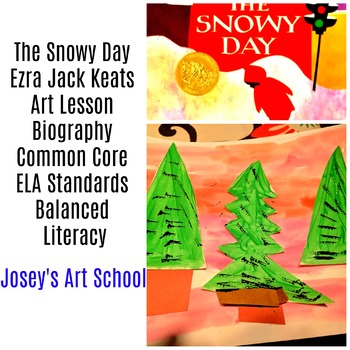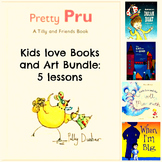Ezra Jack Keats Art Lesson The Snowy Day Pre-K to 3rd Grade
- Word Document File
Also included in
- Are you looking for creative ways to engage your students while incorporating art and literature into your curriculum? Look no further! We have compiled a list of 5 art projects that can be integrated with books featuring silly birds, circus themes, underwater themes, sailboat themes, and city themePrice $5.99Original Price $9.50Save $3.51
Description
Are you looking for a fun and creative way to teach your students about the art of mixed media while exploring the classic children's book, "The Snowy Day" by Ezra Jack Keats? Look no further than our "The Snowy Day" mixed media project! This lesson offers a hands-on opportunity for your students to create a beautiful winter scene inspired by the book, using a variety of materials and techniques.
Using easy-to-follow instructions and step-by-step demonstrations, students will learn how to create a mixed media masterpiece that captures the essence of "The Snowy Day". They will use a variety of materials, such as paint, paper, and cotton balls, to create a textured and visually stunning work of art. Along the way, they will explore the themes of the book, such as wonder, imagination, and the magic of the winter season.
But the benefits of this lesson don't stop there - it also offers multiple opportunities to integrate it into other areas of your curriculum. Here are four ways you can use this lesson to enhance learning in your classroom:
- Literacy - Use this lesson to spark discussion and critical thinking about the book, "The Snowy Day". Encourage your students to explore the themes and symbols in the story and to make connections to their own lives.
- Science - Use the lesson to teach your students about the properties of snow and ice. Discuss the science behind how snowflakes form and how they behave in different weather conditions.
- Social Emotional Learning - Use the lesson to promote empathy and understanding. Encourage your students to think about how the characters in the book might feel and to consider their own feelings during the winter season.
- History and Culture - Use the lesson to explore the historical and cultural context of the book. Discuss the author's background and the impact that "The Snowy Day" has had on children's literature and representation.
This lesson is a wonderful way to promote creativity, critical thinking, and hands-on learning in your classroom. Order our "The Snowy Day" mixed media project today and inspire your students to explore the beauty and wonder of winter through the art of mixed media!
THIS LESSON CONFORMS TO COMMON CORE AND ELA STANDARDS
Inside you will find:
1. famous painting to show your students
2. Brief biography of the artist
3. Questions to ask the students about the art
4. Step by step DETAILED instructions for an art project with FULL COLOR pictures.
5. INSTRUCTIONS ON HOW TO CONFORM THIS LESSON TO COMMON CORE STANDARDS
CLICK HERE to view my freebies
CLICK HERE to view my DRAWING LESSONS
CLICK HERE to view my ART WITH THE MASTERS ART LESSONS
CLICK HERE to view my CONTEMPORARY ART LESSONS
CLICK HERE to view my ART LESSONS THAT COMPLIMENT POPULAR BOOKS
CLICK HERE to view my SELF ESTEEM PROJECTS
CLICK HERE to view my CLASS MURAL IDEAS
CLICK HERE to view my FUN ART FOLK ART LESSONS
CLICK HERE to view my 3 BUNDLED LESSONS
CLICK HERE to view my 5 BUNDLED LESSONS
Make sure to click the GREEN STAR near my store name so that you can stay in touch with my store. I create new lessons every week.



